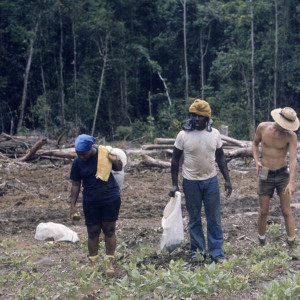
After the events of November 18, 1978, an unsigned, handwritten note was found by the FBI at Jonestown. It is believed to have been written on the final evening by Temple member Richard Tropp, an English teacher.
Collect all the tapes, all the writing, all the history. The story of this movement, this action, must be examined over and over. It must be understood in all of its incredible dimensions.
It has been 35 years since the last day of Peoples Temple. What if, in another 35 years, someone completely new to the Peoples Temple story – or only somewhat aware of how it all ended – wants to learn more, wants to better know and understand the people involved, wants a three-dimensional insight into the human beings beyond a simple list of names?
Please try to understand. Look at all. Look at all in perspective. Look at Jonestown, see what we have tried to do…
To today’s members of the Peoples Temple family, I ask: What are, say, three sources you would most want such a person in the future to read, or see, or hear? What places would you urge curious members of future generations to visit? What resources and references do you think would provide the most complete picture of the Temple story? Would you recommend any “obscure” materials that might only be found “off the beaten path” years from now?
(Please see the histories of our people that are in a building called teachers resource center.)
What are some things – tiny anecdotes, perhaps, or a small act of kindness that shouldn’t be forgotten, or a moment of laughter – that members of the Peoples Temple family would want to share with others in the future, things that might not be found in any easily accessible resource material years from now? Is there a seemingly “trivial” story in their recollection that might give a fullness to the Peoples Temple story, and its people, for interested people who aren’t yet born?
We merge with millions of others, we are subsumed in the archetype.
In the future, there will be many like me. I was first drawn to the Peoples Temple story by the notoriety of the events of November 18. But as I researched, I quickly discovered that there was far more to it. I found wonderful materials – print, video, audio – that made the people in the story much more than a mere list of names. I found myself far more fascinated by how the Temple members lived – especially in the earlier days in Redwood Valley – than how they died. I realized there are many hundreds of Temple stories – a different and compelling one for each person. I came to deeply admire many, many Temple members. I very much want people like me, fifty or more years from now, to be able to find that richer, three-dimensional Temple story. Not just a one-paragraph summary of how it ended, or a five-minute NBC news clip of the final day, or the “death tape.”
Let all the story of this Peoples Temple be told. Let all the books be opened.
I urge all of you who hold a piece of the Temple story in your memory, and in your personal experience, to share either with the Jonestown Institute or the California Historical Society (CHS) your stories and memories – no matter how ”trivial” you think they are. They matter deeply. It could be a song you heard on a radio during an otherwise uneventful moment in, say, June of 1974. Describe the moment for us. Describe simple conversations and everyday interactions. Details that may seem unimportant and uninteresting to you are precisely what will preserve the Temple family as being more than just a headline and a number.
And please send the Jonestown Institute or CHS a short email or letter, suggesting things to read, or listen to, or look up, or watch, or visit. Things that might not come to mind for someone 35 years from now. Over time, the richness and fullness and “three-dimensionalness” of the Temple family will inevitably fade. History does that to us all. But it need not fade completely. Not if you collectively leave a trail of cookie crumbs for those people in the future who will sincerely want to know who you really were, what your lives were like, and how you thought and felt and interacted with one another.
(Mike Lieber is a statistician and lives in Cleveland with his wife and three daughters. He is a regular contributor to the jonestown report. His complete collection of writings for the site are here. He can be reached at mlieber2@ohiohealth.com.)